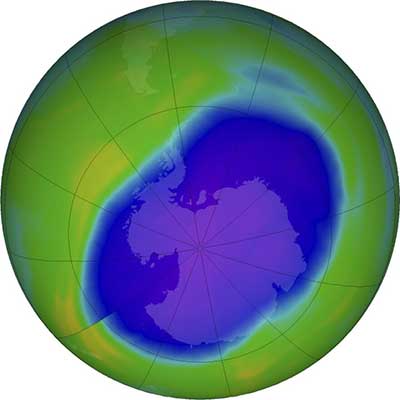Date: 11/01/2023
Relevance: GS-3: Climate Change and International Conventions; Ozone Layer and Montreal Protocol.
Key Phrases: Scientific Assessment of Ozone Depletion 2022, Climate Change, Climate Adaptation, COP(Conference of Parties), Montreal Protocol, Ozone Layer, Credibility, UNEP, Climate Challenge, GHGs Footprint, Chlorofluorocarbon (CFC).
Context:
- Scientific Assessment of Ozone Depletion: 2022 indicates that Earth’s protective ozone layer is slowly but noticeably healing at a pace that would fully mend the hole over Antarctica in about 43 years.
Outcomes of the Report:
- Major achievements of the Montreal Protocol
- Actions taken under the Montreal Protocol continued to decrease
atmospheric abundances of controlled ozone-depleting substances (ODSs)
and advance the recovery of the stratospheric ozone layer.
- The atmospheric abundances of both total tropospheric chlorine and total tropospheric bromine from long-lived ODSs have continued to decline since the 2018 Assessment.
- New studies support previous Assessments in that the decline in ODS emissions due to compliance with the Montreal Protocol avoids global warming of approximately 0.5 -- 1 °C by mid-century compared to an extreme scenario with an uncontrolled increase in ODSs of 3 -- 3.5% per year.
- Actions taken under the Montreal Protocol continue to contribute
to ozone recovery.
- Recovery of ozone in the upper stratosphere is progressing.
- Total column ozone (TCO) in the Antarctic continues to recover, notwithstanding substantial interannual variability in the size, strength, and longevity of the ozone hole.
- TCO is expected to return to 1980 values around 2066 in the Antarctic, around 2045 in the Arctic, and around 2040 for the near-global average (60°N–60°S).
- Compliance with the 2016 Kigali Amendment to the Montreal Protocol, which requires phase down of production and consumption of some hydrofluorocarbons (HFCs), is estimated to avoid 0.3 -- 0.5°C of warming by 2100.
- Actions taken under the Montreal Protocol continued to decrease
atmospheric abundances of controlled ozone-depleting substances (ODSs)
and advance the recovery of the stratospheric ozone layer.
- Current Scientific and Policy Challenges
- The recent identification of unexpected CFC-11 emissions led to
scientific investigations and policy responses.
- Observations and analyses revealed the source region for at least half of these emissions and substantial emissions reductions followed.
- Regional data suggest some CFC-12 emissions may have been associated with the unreported CFC-11 production.
- Unexplained emissions have been identified for other ODSs
(CFCs-13, 112a, 113a, 114a, 115, and CCl4), as well as HFC-23.
- Some of these unexplained emissions are likely occurring as leaks of feedstocks or by-products, and the remainder is not understood.
- Outside of the polar regions, observations and models are in
agreement that ozone in the upper stratosphere continues to recover.
- In contrast, ozone in the lower stratosphere has not shown signs of recovery.
- Models simulate a small recovery in mid-latitude lower-stratospheric ozone in both hemispheres that is not seen in observations.
- Reconciling this discrepancy is key to ensuring a full understanding of ozone recovery.
- The existing network of atmospheric monitoring stations provides
measurements of global surface concentrations of long-lived ODSs and
HFCs resulting from anthropogenic emissions.
- However, gaps in regional atmospheric monitoring limit the scientific community’s ability to identify and quantify emissions of controlled substances from many source regions.
- The impact on the ozone layer of stratospheric aerosol injection (SAI),
which has been proposed as a possible option to offset global warming,
has been assessed following the terms of reference for the 2022 SAP
Assessment Report.
- Important potential consequences, such as deepening of the Antarctic ozone hole and delay in ozone recovery, were identified.
- Many knowledge gaps and uncertainties prevent a more robust evaluation at this time.
- The recent identification of unexpected CFC-11 emissions led to
scientific investigations and policy responses.
Montreal Protocol
- The Montreal Protocol is an international treaty designed to protect the ozone layer by phasing out the production of numerous substances that are responsible for ozone depletion (known as ozone-depleting substances).
- It was agreed on 16 September 1987, and entered into force on 1 January 1989.
- Since then, it has undergone nine revisions including the latest one in 2016 (Kigali).
- For each group of ODSs, the treaty provides a timetable on which the production of those substances must be reduced and eventually eliminated.
- On 1 January 2019 the Kigali Amendment to the Montreal Protocol came
into force.
- Under the Kigali Amendment countries promised to reduce the use of hydrofluorocarbons (HFCs) by more than 80% over the next 30 years.
- Future Policy Considerations
- If ODS feedstock emissions as currently estimated were to be eliminated in future years, the return of mid-latitude Equivalent Effective Stratospheric Chlorine (EESC) to 1980 abundances could be advanced by almost 4 years.
- Eliminating future emissions of methyl bromide (CH3Br) from quarantine and pre-shipment applications currently allowed by the Montreal Protocol would accelerate the return of mid-latitude EESC to 1980 abundances by two years.
- Emissions of anthropogenic very short-lived chlorine substances, dominated by dichloromethane (CH2Cl2), continue to grow and contribute to ozone depletion.
- A 3% reduction in anthropogenic N2O emissions, averaged over 2023–2070, would lead to an increase in annually averaged global TCO of about 0.5 DU over the same period.
- Global emissions of long-lived HFC-23, which are largely a by-product of HCFC-22 production, are as much as eight times larger than expected and are likely to grow unless abatement increases during HCFC-22 production or feedstock use of HCFC-22 decreases.
Conclusion:
- Reductions in the future emissions of CFCs and HCFCs require addressing releases from banks and continuing production and use in allowed manufacturing of feedstocks, in by-products, or in unknown uses, depending upon the compound.
Source: TheHindu
Mains Question:
Q. What are the major achievements of the Montreal Protocol? Also, discuss the current scientific and policy challenges. (150 Words).






















